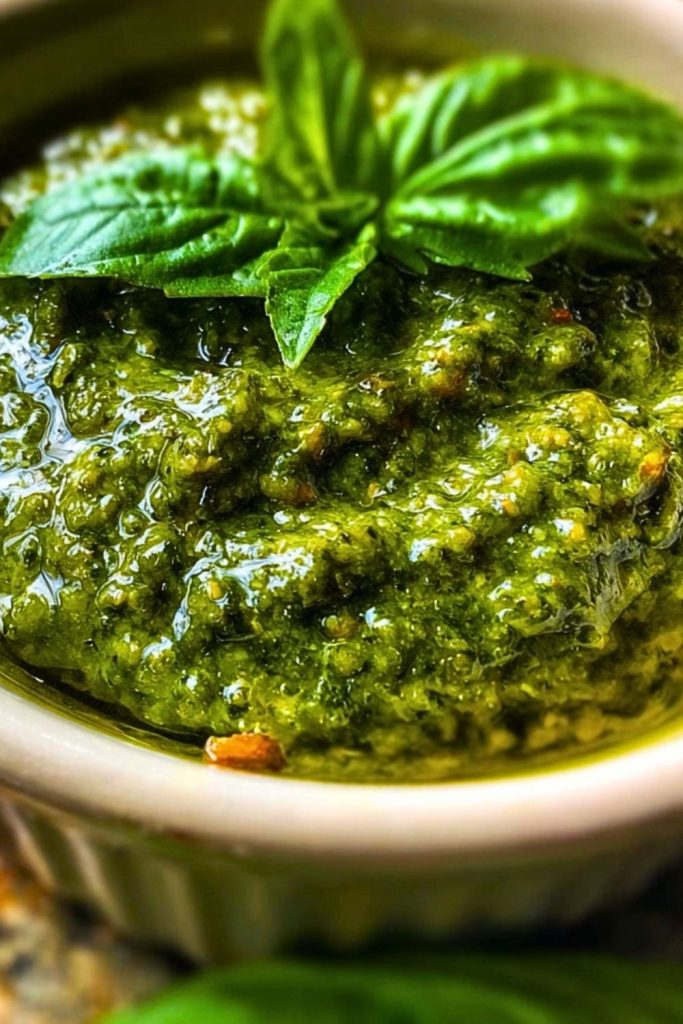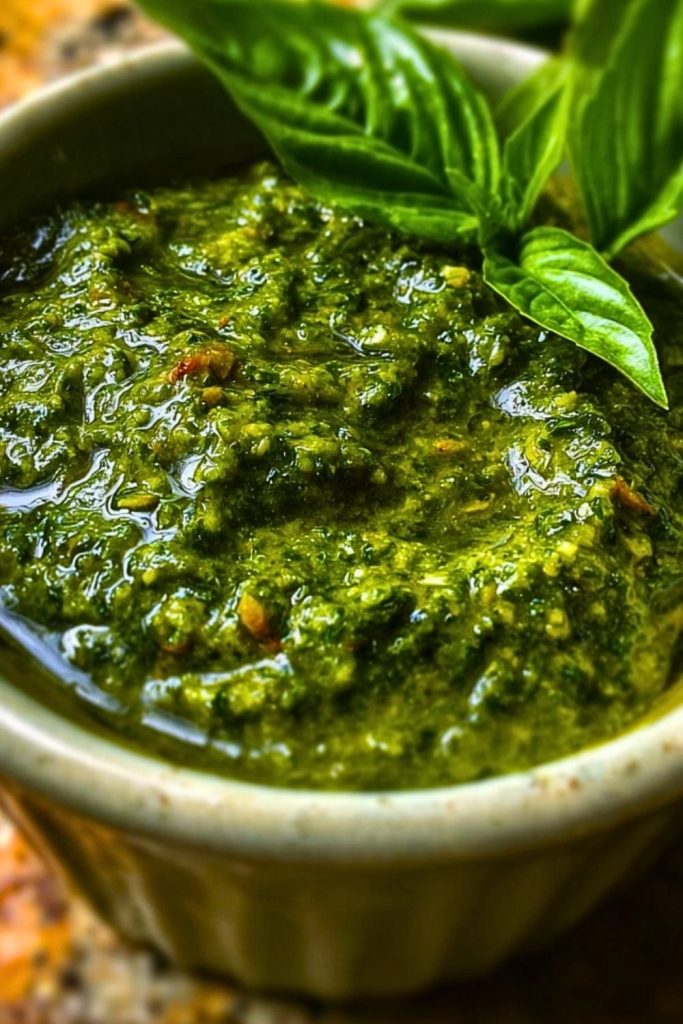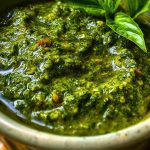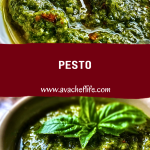Fragrant, vibrant, and incredibly versatile, homemade basil pesto is a true celebration of fresh, simple ingredients. This emerald green sauce brings together the richness of olive oil, the nutty crunch of pine nuts, the sharp tang of Parmesan, and the aromatic punch of basil leaves. When blended into a smooth yet textured paste, pesto becomes more than just a sauce—it’s a burst of Mediterranean sunshine in every spoonful.

Whether you drizzle it over freshly cooked pasta, smear it on sandwiches, spoon it over grilled vegetables, or use it as a dip, pesto elevates any dish with ease. Making it at home not only gives you control over the flavor and texture, but it also ensures the freshest, most vibrant result that store-bought versions just can’t match.
Why You’ll Love This Homemade Basil Pesto
- It’s incredibly quick to make—ready in under 10 minutes.
- Requires just a few wholesome, fresh ingredients.
- Packed with flavor and perfect for pasta, toast, or as a marinade.
- Customizable based on your taste or dietary needs.
- A great way to use up extra basil from your garden.
Preparation Phase & Tools to Use
To make the smoothest, most flavorful pesto, a few kitchen tools will make the process effortless:
- Food Processor or Blender: This is the star tool. It quickly combines the ingredients to the perfect consistency. A food processor allows better control over texture, while a high-speed blender yields a creamier result.
- Rubber Spatula: Essential for scraping down the sides of the food processor to ensure everything is evenly blended.
- Measuring Cups and Spoons: To keep ingredient ratios accurate.
- Microplane or Cheese Grater: For freshly grating the Parmesan, which blends smoother and tastes better than pre-shredded cheese.
- Airtight Container: For storing any leftover pesto in the fridge or freezer.
Preparation Tips
Use the freshest basil leaves you can find—look for vibrant green leaves with no signs of wilting. Toasting the pine nuts beforehand adds a deeper, richer flavor, so don’t skip that step. Always add the olive oil gradually while blending to create a smoother emulsion, and for best results, use high-quality extra virgin olive oil. If you like a bit of a spicy kick, a small garlic clove goes a long way. Finally, if your pesto looks too thick, just add a splash more olive oil until you reach your desired consistency.
Ingredients for this Pesto
- 2 cups fresh basil leaves, packed
- 1/2 cup grated Parmesan cheese
- 1/2 cup extra virgin olive oil
- 1/3 cup pine nuts (toasted)
- 2 garlic cloves, peeled
- 1/4 teaspoon salt (or to taste)
- Optional: a squeeze of lemon juice for brightness

Step 1: Toast the Pine Nuts
In a dry skillet over medium heat, toast the pine nuts for 2–3 minutes, stirring frequently, until they turn golden and aromatic. Remove from heat and let them cool.
Step 2: Blend the Basil, Nuts, and Garlic
In a food processor, combine the basil leaves, cooled pine nuts, and garlic. Pulse several times until the mixture is finely chopped.
Step 3: Add Parmesan and Salt
Add the grated Parmesan cheese and salt to the mixture. Pulse again until everything is incorporated evenly.
Step 4: Stream in the Olive Oil
While the food processor is running, slowly stream in the olive oil. Blend until the pesto reaches a creamy, spreadable consistency.
Step 5: Taste and Adjust
Taste your pesto and adjust seasoning as needed. Add more salt, cheese, or a squeeze of lemon juice for extra brightness.
Step 6: Store or Serve
Use immediately or transfer to an airtight container. Drizzle a thin layer of olive oil on top to prevent oxidation if storing. Keep refrigerated for up to 5 days or freeze for longer shelf life.
Notes
For a smoother pesto, blend the olive oil in slowly while the food processor is running. This helps the mixture emulsify and become creamy. If you want to make a dairy-free version, simply swap out the Parmesan for nutritional yeast or a vegan hard cheese alternative. You can also experiment with different nuts—walnuts, almonds, or cashews can bring a new flavor profile while keeping the texture rich.
Watch Out for These Mistakes While Cooking
- Using old or bruised basil leaves: This can make your pesto taste bitter or dull.
- Over-toasting the pine nuts: A burnt nut will overpower the delicate basil flavor.
- Skipping the slow drizzle of olive oil: Dumping it all in at once can separate the oil from the solids, leading to a greasy or broken texture.
- Using pre-shredded cheese: It often contains anti-caking agents, which can negatively affect the pesto’s texture.
- Storing without oil covering: Not sealing the top with oil leads to oxidation and browning.
Storage Instructions
Store your homemade pesto in a glass jar or airtight container. Pour a thin layer of olive oil over the surface before sealing—this helps prevent oxidation and keeps the vibrant green color intact. It will stay fresh in the fridge for up to 5 days. You can also freeze pesto in ice cube trays for convenient single-use portions; just pop them out and store in a freezer bag for up to 3 months.
Estimated Nutrition
Serving Size: 2 tablespoons
- Calories: 190
- Total Fat: 19g
- Saturated Fat: 3g
- Cholesterol: 5mg
- Sodium: 150mg
- Total Carbohydrates: 2g
- Dietary Fiber: 1g
- Sugars: 0g
- Protein: 3g
Frequently Asked Questions
Can I make pesto without a food processor?
Yes! You can use a mortar and pestle for a more traditional and rustic texture, though it takes more time.
Can I freeze pesto?
Absolutely. Freeze in ice cube trays, then transfer the cubes to a zip-top bag and store for up to 3 months.
What can I use instead of pine nuts?
Walnuts, almonds, cashews, or even sunflower seeds are great alternatives.
How do I fix bitter pesto?
Try adding a pinch of sugar or a bit more cheese to balance out the bitterness. Using younger basil leaves can also help.
Is pesto gluten-free?
Yes, all the ingredients in traditional pesto are naturally gluten-free.
Can I make pesto without cheese?
Yes, just substitute nutritional yeast or a vegan cheese to keep it dairy-free.
How long does homemade pesto last?
Up to 5 days in the fridge with an oil layer on top, or 3 months in the freezer.
Why is my pesto turning brown?
Oxidation is the cause. Always cover the surface with olive oil and store in an airtight container.
Conclusion
Making pesto at home is a small act of culinary joy that brings big rewards. It’s fresh, fast, and full of bold flavor that’s ready to transform countless meals. Whether you use it as a pasta sauce, sandwich spread, or veggie dip, this versatile sauce deserves a permanent spot in your recipe rotation. Try it once, and you’ll never look at store-bought pesto the same way again.

Pesto
- Prep Time: 10 minutes
- Cook Time: 0 minutes
- Total Time: 10 minutes
- Yield: 1 cup
- Category: Sauce
- Method: Blending
- Cuisine: Italian
- Diet: Vegetarian
Description
Fresh, bold, and bursting with vibrant flavor, this classic pesto recipe is a must-have in every kitchen. It’s the perfect balance of aromatic basil, rich Parmesan, crunchy pine nuts, and silky olive oil. Whether you’re searching for a quick breakfast spread, a sauce for your easy dinner pasta, or looking for healthy snack ideas—this versatile pesto covers all your favorite food ideas in one easy recipe. A total game-changer for weeknight meals and weekend cooking alike!
Ingredients
2 cups fresh basil leaves, packed
1/2 cup grated Parmesan cheese
1/2 cup extra virgin olive oil
1/3 cup pine nuts (toasted)
2 garlic cloves, peeled
1/4 teaspoon salt
1 teaspoon lemon juice (optional)
Instructions
1. In a dry skillet over medium heat, toast the pine nuts for 2–3 minutes, stirring frequently, until golden and aromatic. Let cool.
2. In a food processor, combine basil leaves, cooled pine nuts, and garlic. Pulse several times until finely chopped.
3. Add grated Parmesan cheese and salt. Pulse again to combine evenly.
4. While the processor is running, slowly stream in olive oil until creamy and smooth.
5. Taste and adjust seasoning. Add lemon juice if using.
6. Use immediately or transfer to an airtight container. Cover with olive oil to preserve and refrigerate or freeze.
Notes
Use the freshest basil possible for the brightest flavor.
Toast the nuts lightly for a richer depth of taste.
Cover with olive oil before storing to prevent browning.
Nutrition
- Serving Size: 2 tablespoons
- Calories: 190
- Sugar: 0g
- Sodium: 150mg
- Fat: 19g
- Saturated Fat: 3g
- Unsaturated Fat: 15g
- Trans Fat: 0g
- Carbohydrates: 2g
- Fiber: 1g
- Protein: 3g
- Cholesterol: 5mg
Keywords: pesto, basil pesto, easy recipe, quick sauce, healthy snack, dinner ideas, food ideas

